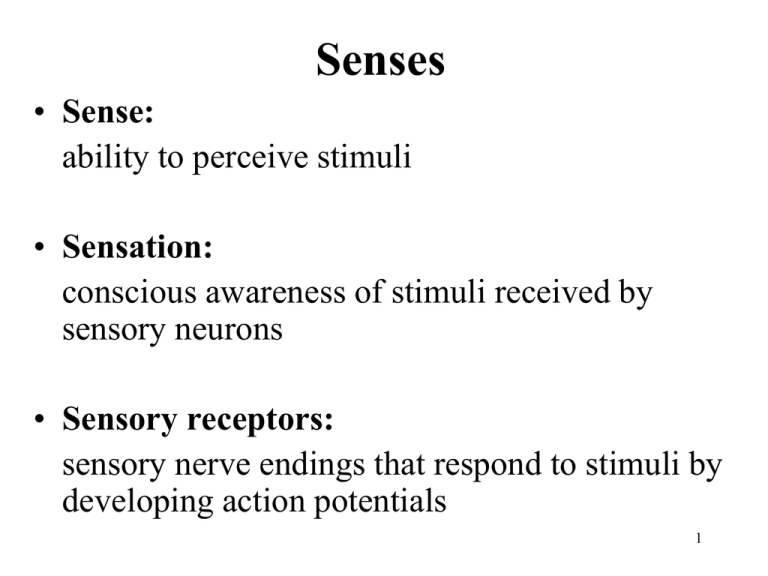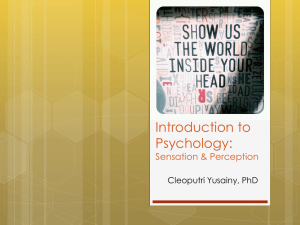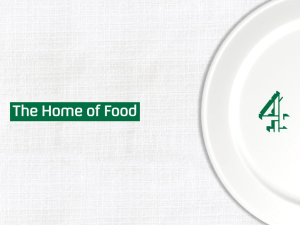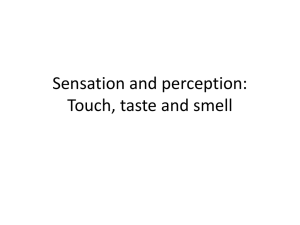Special Senses
advertisement

Senses • Sense: ability to perceive stimuli • Sensation: conscious awareness of stimuli received by sensory neurons • Sensory receptors: sensory nerve endings that respond to stimuli by developing action potentials 1 Types of Senses • General senses: - receptors over large part of body - somatic provide info. about body and env’t - visceral provide info. about internal organs, pain, pressure - touch, pressure, pain, temp., and itch • Special senses: smell, taste, sight, hearing, and balance Types of Receptors • Mechanoreceptors: - detect movement - Ex. touch, pressure, vibration • Chemoreceptors: - detect chemicals - Ex. Odors • Photoreceptors: detect light 3 • Thermoreceptors: detect temp. changes • Nociceptors: detect pain 4 Types of Touch Receptors • Merkel’s disk: detect light touch and pressure • Hair follicle receptors: detect light touch • Meissner corpuscle: - deep in epidermis - localizing tactile sensations • Ruffini corpuscle: - deep tactile receptors - detects continuous pressure in skin • Pacinian corpuscle: - deepest receptors - associated with tendons and joints - detect deep pressure, vibration, position Figure 9.1 Pain • What is it? unpleasant perceptual and emotional experience 8 Types of Pain • Localized: - sharp, pricking, cutting pain - rapid action potential • Diffuse: - burning, aching pain - slower action potentials 9 Pain Control • Local anesthesia: - action potentials suppressed from pain receptors in local areas - chemicals are injected near sensory nerve • General anesthesia: - loss of consciousness - chemicals affect reticular formation 10 Referred Pain • What is it? - originates in a region that is not source of pain stimulus - felt when internal organs are damaged or inflamed - sensory neurons from superficial area and neurons of source pain converge onto same ascending neurons of spinal cord Olfaction • What is it? - sense of smell - occurs in response to odorants - receptors are located in nasal cavity and hard palate - we can detected 10,000 different smells 13 How does olfaction work? 1. Nasal cavity contains a thin film of mucous where odors become dissolved. 2. Olfactory neurons are located in mucous. Dendrites of olfactory neurons are enlarged and contain cilia. 3. Dendrites pick up odor, depolarize, and carry odor to axons in olfactory bulb (cranial nerve I). 4. Frontal and temporal lobes process odor. 14 Figure 9.3b Taste • Taste buds: - sensory structures that detect taste - located on papillae on tongue, hard palate, throat • Inside each taste bud are 40 taste cells • Each taste cell has taste hairs that extend into taste pores 16 Figure 9.4 How does taste work? 1. Taste buds pick up taste and send it to taste cells. 2. Taste cells send taste to taste hairs. 3. Taste hairs contain receptors that initiate an action potential which is carried to parietal lobe. 4. Brain processes taste. 18 Types of Tastes • • • • • Sweet Sour Salty Bitter Umami • Certain taste buds are more sensitive to certain tastes. • Taste is also linked to smell. 19 Vision Accessory Structures • Eyebrow: - protects from sweat - shade from sun • Eyelid/Eyelashes: - protects from foreign objects - lubricates by blinking 20 • Conjunctiva: thin membrane that covers inner surface of eyelid • Lacrimal apparatus: produces tears • Extrinsic eye muscles: help move eyeball 22 Figure 9.8 Anatomy of Eye • Hollow, fluid filled sphere • Composed of 3 layers (tunics) • Divided into chambers 26 Fibrous Tunic • Outermost layer • Sclera: - firm, white outer part - helps maintain eye shape, provides attachment sites, protects internal structures • Cornea: - transparent structure that covers iris and pupil - allows light to enter and focuses light Vascular Tunic • Middle layer • Contains blood supply • Choroid: - black part (melanin) - delivers O2 and nutrients to retina • Ciliary body: helps hold lens in place • Suspensory ligaments: help hold lens in place 28 • Lens: - flexible disk - focuses light onto retina • Iris: - colored part - surrounds and regulates pupil • Pupil: - regulates amount of light entering - lots of light = constricted - little light = dilated 29 Figure 9.10 Nervous Tunic • Innermost tunic • Retina: - covers posterior 5/6 of eye - contains 2 layers • Pigmented retina: - outer layer - keeps light from reflecting back in eye • Sensory retina: - contains photoreceptors (rods and cones) - contains interneurons • Rods: - photoreceptor sensitive to light - 20 times more rods than cones - can function in dim light • Cones: - photoreceptor provide color vision - 3 types blue, green, red Figure 9.12b Figure 9.12c • Rhodopsin: photosensitive pigment in rod cells • Opsin: colorless protein in rhodopsin • Retinal: - yellow pigment in rhodopsin - requires vitamin A 36 Effects of Light on Rhodopsin 1. 2. 3. 4. 5. Light strikes rod cell Retinal changes shape Opsin changes shape Retinal dissociates from opsin Change rhodopsin shape stimulates response in rod cell which results in vision 6. Retinal detaches from opsin 7. ATP required to reattach retinal to opsin and return rhodopsin to original shape Figure 9.13 Retina Structures Continued • Rods and cones synapse with bipolar cells of sensory retina • Horizontal cells of retina modify output of rods and cones • Bipolar and horizontal cells synapse with ganglion cells • Ganglion cells axons’ converge to form optic nerve Nervous Tunic (Retina) • Innermost layer • 2 parts of retina: sensory and pigmented • Keeps light from reflecting back into eye • Rods: photoreceptors that detect amount light • Cones: - photoreceptors that detect colors - 3 types: red, blue, green 40 • Macula: small spot near center of retina • Fovea centralis: - center of macula - where light is focused when looking directly at an object - only cones - ability to discriminate fine images • Optic disk: - white spot medial to macula - blood vessels enter eye and spread over retina - axons exit as optic nerve - no photoreceptors - called blindspot Chambers of Eye • Anterior chamber: - located between cornea and lens - filled with aqueous humor (watery) - aqueous humor helps maintain pressure, refracts light, and provide nutrients to inner surface of eye • Posterior chamber: - located behind anterior chamber - contains aqueous humor 44 • Vitreous chamber: - located in retina region - filled with vitreous humor: jelly-like substance - vitreous humor helps maintain pressure, holds lens and retina in place, refracts light 45 Functions of Eye Light Refraction Bending of light • Focal point: - point where light rays converge - occurs anterior to retina - object is inverted Focusing Images on Retina • Accommodation: - lens becomes less rounded and image can be focused on retina - enables eye to focus on images closer than 20 feet Neuronal Pathway for Vision • Optic nerve: leaves eye and exits orbit through optic foramen to enter cranial cavity • Optic chiasm: where 2 optic nerves connect • Optic tracts: route of ganglion axons Figure 9.16b Eye Defects • Myopia: - nearsightedness - image is in front of retina • Hyperopia: - farsightedness - image is behind retina • Presbyopia: - lens becomes less elastic - reading glasses required 51 Clinical Focus 9A • Astigmatism: - irregular curvature of lens - glasses or contacts required to correct • Colorblindness: - absence or deficient cones - primarily in males • Glaucoma: - decreased pressure in eye - can lead to blindness 53 Clinical Focus 9B Hearing and Balance External (Outer) Ear • Extends from outside of head to eardrum • Auricle: fleshy part on outside • External auditory meatus: canal that leads to eardrum • Tympanic membrane: - eardrum - thin membrane that separates external and 55 middle ear Middle Ear • Air filled chamber • Malleus (hammer): bone attached to tympanic membrane • Incus (anvil): bone that connects malleus to stapes • Stapes (stirrup): bone located at base of oval window 56 • Oval window: separates middle and inner ear • Eustachian or auditory tube: - opens into pharynx - equalizes air pressure between outside air and middle ear 57 58 Inner Ear • Set of fluid filled chambers • Bony labyrinth: - tunnels filled with fluid - 3 regions: cochlea, vestibule, semicircular canals • Membranous labyrinth: - inside bony labyrinth - filled with endolymph 59 • Endolymph: clear fluid in membranous labyrinth • Perilymph: fluid between membranous and bony labyrinth • Cochlea: - snail-shell shaped structure - where hearing takes place • Scala vestibuli: - in cochlea - filled with perilymph • Scala tympani: - in cochlea - filled with perilymph • Cochlea duct: - in cochlea - filled with endolymph • Spiral organ: - in cochlear duct - contains hair cells • Tectorial membrane: - in cochlea - vibrates against hair cells • Hair cells: attached to sensory neurons that when bent produce an action potential • Vestibular membrane: wall of membranous labyrinth that lines scala vestibuli • Basilar membrane: wall of membranous labyrinth that lines scala tympani How do we hear? 1. Sound travels in waves through air and is funneled into ear by auricle. 2. Auricle through external auditory meatus to tympanic membrane. 3. Tympanic membrane vibrates and sound is amplified by malleus, incus, stapes which transmit sound to oval window. 4. Oval window produces waves in perilymph of cochlea. 65 5. Vibrations of perilymph cause vestibular membrane and endolymph to vibrate. 6. Endolymph cause displacement of basilar membrane. 7. Movement of basilar membrane is detected by hair hairs in spiral organ. 8. Hair cells become bent and cause action potential is created. 66 Balance (Equilibrium) • Static equilibrium: - associated with vestibule - evaluates position of head relative to gravity • Dynamic equilibrium: - associated with semicircular canals - evaluates changes in direction and rate of head movement • Vestibule: - inner ear - contains utricle and saccule • Maculae: - specialized patches of epithelium in utricle and saccule surround by endolymph - contain hair cells • Otoliths: - gelatinous substance that moves in response to gravity - attached to hair cell microvilli which initiate action potentials • Semicircular canals: - dynamic equil. - sense movement if any direction • Ampulla: base of semicircular canal • Crista ampullaris: in ampulla • Cupula: - gelatinous mass - contains microvilli - float that is displaced by endolymph movement 72








